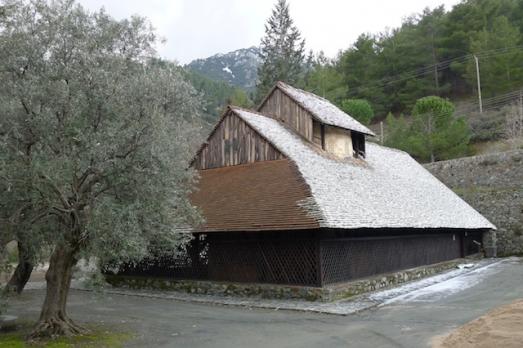
Panagia tou Araka
Lagoudera, CY
Panagia tou Araka is one of the painted churches of the Troodos Mountains. It has been a UNESCO World Heritage Site since 1985.
Here you can search for a building to visit. You can use the map find destinations, or you can use the filters to search for a building based upon what different criteria.

Lagoudera, CY
Panagia tou Araka is one of the painted churches of the Troodos Mountains. It has been a UNESCO World Heritage Site since 1985.

Moutoullas, CY
Panagia tou Moutoulla is one of the painted churches of the Troodos Mountains. It has been a UNESCO World Heritage Site since 1985.

Pentalia, CY
The monastery of Panagia tu Sinti, founded in the 13th century, is a former Orthodox monastery with Cypriot-Venetian architecture. Renovated from 1993 to 1997, it is under the protection of UNESCO.

Ano Mera, GR
This 14th-century monastery in Ano Mera is dedicated to Panagia Tourliani, the patroness of Mykonos island, and is a popular destination for pilgrims since the 16th century.

Agios Nikolaos, GR
Panagia Vrefotrofos is a church dedicated to Virgin Mary in the old town of Agios Nikolaos. The church preserves two layers of mural paintings, the first one dating from the early 14th century and the second from the second half of the 14th century.

Agios Amvrosios, CY
This church with a dome-hall was built in the 12th century and is located approx. three kilometres south-east from the village centre.

Faraggi, GR
Panagia Zerviotisa is a stone Byzantine church close to the village of Faraggi, on the island of Crete.
Leiden, NL
Large medieval city church. In use (2021) as a church of the PKN (Protestant Church of the Netherlands).
Diever, NL
The church building is one of the oldest churches in Drenthe and was dedicated to Saint Pancratius before the Reformation. Its origins date back to the 9th century. In the centuries that followed, the wooden church made way for a tuff stone Romanesque church with a freestanding tower. In the 14th century, the closed choir was replaced by the current Gothic polygonal choir. Two centuries later, the side aisles were added, enclosing the tower and giving the building its current form. The building was destroyed by lightning in 1759. The memorial stone on the south facade commemorates this event. The church was restored in 1959.
Brummen, NL
Built in 1402, renovated in 1451 and 1937. The pointed top blew off in 1818. The oldest part of the church, the tower, dates from the first half of the 15th century, probably 1402. A chapel had already stood on this site for several centuries. Above the pulpit, a stone with the date 1451 possibly commemorates the first renovation. The lower part of the tower consists of tuff, above that layers of tuff alternate with brick and the upper part consists only of brick. During a heavy storm in 1818, the pointed top of the tower blew off. A few years later, the tower was restored and the spherical hat was created. In 1937, the church was expanded on the south side to its current form. In the tower hangs a bell cast in 1742 with a diameter of 140 cm. There used to be a small school on the north side (see also the construction drawing). The current land registry drawings show that the land under the former school is still owned by the church. The church in Brummen probably dates from the tenth century and was dedicated to Saint Pancratius. It was under the patronage of the Abbess of the imperial foundation in Elten, where the abbey was richly endowed with many goods by Wichman, Count of Hameland, including the lordship of Brummen. The church had already been somewhat renovated in the eleventh century in a more Romanesque style. The tower was then less high than it is today. In the middle of the fifteenth century the building underwent another change, while in the middle of the eighteenth century another renovation took place.

new
Nestled amidst the serene landscapes of the Harz region, lies a hidden gem for nature enthusiasts and history buffs alike - the Harz Monastery Hiking Trail. Lace up your hiking boots and embark on this captivating adventure that will transport you back in time.

The Holy Mile (Miglio Sacro) of Naples is a one-mile-long itinerary, through sacred places linked to the city's patron saint, San Gennaro, in the Rione Sanità district. Discover the city from a new perspective with this unique walking tour.

As a university city, cultural offerings abound in Tartu and will reach their peak after being designated one of three European Capitals of Culture for 2024. In this list, we've compiled the most interesting sacred places to visit in and around the old town.